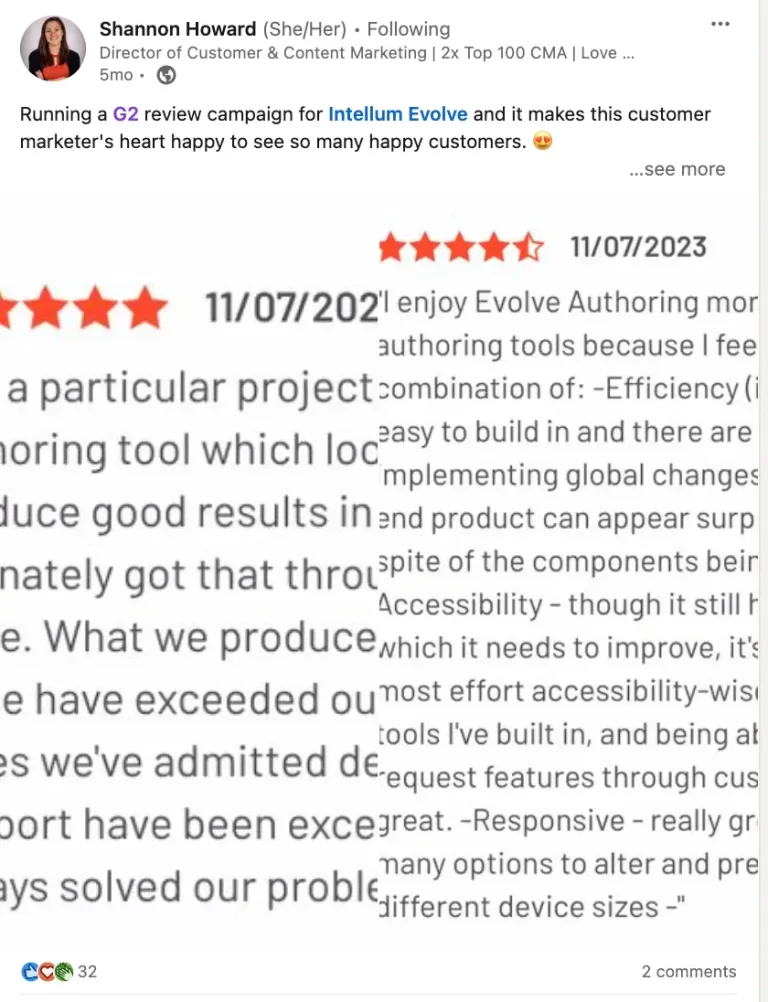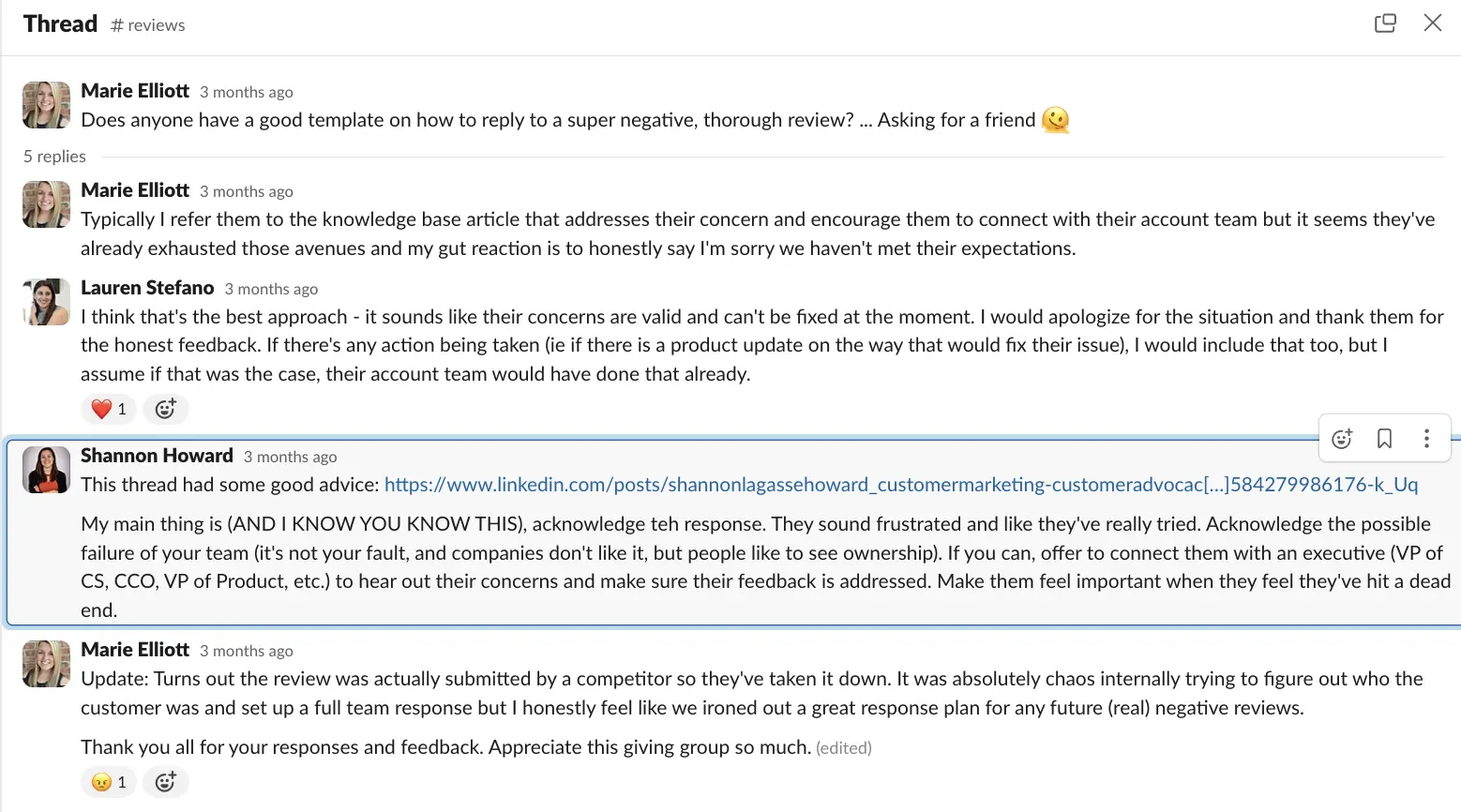Intro
Today’s guest is Shannon Howard, the Director of Customer & Content Marketing at Intellum.
Shannon is a 2x Top100 CMA winner. She covers the intersection of customer marketing, customer education, and content marketing. She’s also one of the best in the customer marketing and advocacy community when it comes to sharing her expertise.
I’m so happy she was up to share her views on reviews.
Here they are 🤩:
Questions:
Q: What drew you to a career in Customer Marketing & Advocacy?
A: Like many people, I kind of “fell into” customer marketing. What I love about it is focusing on building strong relationships with customers, helping them be successful, and sharing those stories with other potential customers to inspire them.
Q: What was your first review generation campaign? Which was your favourite / most effective?)
A: I can’t actually recall which was the first review campaign I ran! But you linked to one of my favorites, which we ran in the fall for Intellum Evolve, our content authoring tool. I just love an active user base that loves a product—and Evolve customers are those types of people!
Q: Customer Marketers do so much, as you’ve outlined in this post (below) on LinkedIn. How do you determine where reviews fit in your list of priorities? And how did you land on a number of reviews (on G2 and Capterra) and your product ratings on those sites as your review goals?
A: When figuring out where a program fits in the mix, I think about priority and impact.
As a team of one, I can’t do it all. We look at a variety of factors to determine impact: what’s critical to the buying journey, requests we’re getting from Sales for customer collateral, and where we’re behind.
I’ll take a moment to explain “where we’re behind.” I don’t honestly believe that every customer will read reviews or a case study. But they WILL look to see how many reviews you have and rating compared to competitors. They WILL look at how many case studies you have in your library as a reflection of customer count and happiness. So we factor that in.
When setting review goals, it comes down to two things: 1) Understanding the size of my customer base and response rates and 2) How much bandwidth my customer-facing teammates have to support. So I try to set reasonable growth goals based on those two things.
Q: What are the key considerations vendors should make before starting review generation?
A: Some key considerations (from my point of view):
Focus where your people are. Google your company name + reviews and see which sites pop up and where there are reviews already. Don’t try to cover them all, but pick the top few your customers and prospects use.
Understand the type of lift you’ll need. Some sites (like G2) offer to run campaigns for you. This can save you a lot of time—but you need to know if that’s going to work for you. Do you need to send a priming email? Do you need CSM assistance to follow up?
Keep in mind that there’s no one-size-fits-all approach to review. For example, we have a downmarket product where buyers are users. We can run a G2 campaign through G2 and collect a ton of reviews. But for our upmarket product, we’ve found the most success in offering two-way incentives (G2-incentivized customer review, internal incentivize for CSMs to drive reviews. We’ve also found, for both products, “always on” review collection (in community, email signatures, learning hub, etc.) doesn’t drive anything, so we stop spending that real estate trying to drive reviews.
Do more than collect reviews. Review collection is a start—but your team needs to use those reviews for other purposes, like in pitch decks, on your website, etc. This slide deck from the CMA Weekly community highlights ideas of how you can use and repurpose these reviews.
Q) What’s your view on using spiffs to incentivize your colleagues in CS and Sales to ask for reviews? Your question on it sparked a lot of input from the CMA community!
A: If it works, go for it! I used to think “You get paid to do your job. Why should I incentivize you to do this?” but it really does make a difference. People get excited, and honestly, I love to send them gift cards! I actually signed off my spiff email “Go forth and get some reviews! I look forward to sending you all gift cards in the near future.”
Q: You do a great job of “walking the talk” of responding to reviews. So many B2B SaaS vendors and professionals struggle (me included 🙋) with this one. They know they should respond to reviews, but don’t because they’re not sure how (Who should respond? What do you say? How do you find time to do it?) How did you make it happen, and what are top tips to others on it?
A: Sometimes I feel like I end up in really privileged situations where people just trust me to do the job. With review sites, that means authority to respond to reviews.
My advice for other people would be: Don’t wait for someone else to respond (unless there’s already a designated person). If something is everyone’s job, it’s no one’s job. Err on the side of being proactive and customer-first by leaving a response. I try to keep it general, using the tips from that LinkedIn post.
If I can figure out who the customer is, I’ll pass along the feedback to their CSM. If they call out things in the product or with support, I’ll send their way as well. But I try to be quick to acknowledge the review, thank people for taking the time, celebrate what’s working, and offer a next step (we’ll look into this, I’ll send this as a suggestion to our product team, etc.)
Q) As a hybrid Customer Marketer and Content Marketer, how do view customer reviews as part of marketing content? What can vendors do to leverage their reviews in their content?
A: You could think about this in two ways: One is to reach out to those customers to share their experience, expertise, and insights in content.
I’m always looking for ways to highlight our customers and industry voices in our content—and reviews can surface people I might not otherwise have met.
Another possibility is to use the review to validate something you’re saying in a blog. Almost like, “Don’t take my word for it. Look what this person had to say.”
Q) Based on your experience in Customer Education, is there a way to ask for reviews in the customer education process? If so, how?
This is an interesting idea!
To be honest, we collect feedback from customer education, but I would say I might proceed with caution here.
Education is one part of what your company offers (as is community, etc.). Just because a customer is happy with one part doesn’t mean they’re thrilled about the whole.
I would consider engagement with customer education as part of a health score or engagement score indicating customers to reach out to, but I don’t know that I’d ask for a review in follow up to a workshop or training.
Q) Based on your experience in Customer Marketing & Advocacy, what’s your view on how business software reviews will evolve?
Industry analyst I am not, but I think people are leaning away from reviews. I know, as a B2B buyer, I am.
I’m more likely to reach out to someone I know who uses a product to get their candid feedback than read a review.
As someone who works in customer marketing, I know these are likely the “happy customers” and not a reflection of the full customer base. So maybe it’s one data point, but I’m also asking in online communities and talking to individuals before making a decision.
Key Takeaways
- Tailor Review Strategies to Product Segments: Understand the different needs of your customer segments and tailor your review generation campaigns accordingly. For example, downmarket products might benefit from direct campaigns through platforms like G2, while upmarket products may require more personalized approaches, such as two-way incentives.
- Set Realistic Review Goals: Base your goals on the size of your customer base and the bandwidth of your team. Set achievable targets for review quantity and quality that align with your team’s capacity and customer engagement levels.
- Leverage Reviews Across Marketing Channels: Don’t just collect reviews; use them strategically in marketing materials, such as pitch decks and websites, to enhance credibility and influence prospective customers.
- Incentivize Internal Teams Effectively: Motivate your customer service and sales teams to encourage review submissions by offering incentives. This can significantly increase engagement and participation, translating into more reviews and higher quality feedback.
- Be Proactive in Responding to Reviews: Develop a strategy for promptly and effectively responding to reviews. Assign responsibility clearly within your team to ensure that responses are timely and constructive, enhancing customer satisfaction and trust.
Authors
-

I'm the Founder and Editor-In-Chief of B2B SaaS Reviews and the Director of Demand Generation at PartnerStack, the leading platform for partner management and affiliate marketing in B2B SaaS. My experience spans several notable B2B SaaS companies, including Influitive (Advocate Marketing), LevelJump (Sales Enablement, acquired by Salesforce), and Eloqua (Marketing Automation, acquired by Oracle). I hold a Bachelor of Commerce in Marketing Management from Toronto Metropolitan University and a Master of International Business from Queen's University, with academic exchanges at Copenhagen Business School and Bocconi University.
-

Shannon Howard is the Director of Customer & Content Marketing at Intellum. She is a 2x Top100 CMA winner, and is one of the best in the customer marketing and advocacy community when it comes to sharing her expertise. She covers the intersection of customer marketing, customer education, and content marketing.








